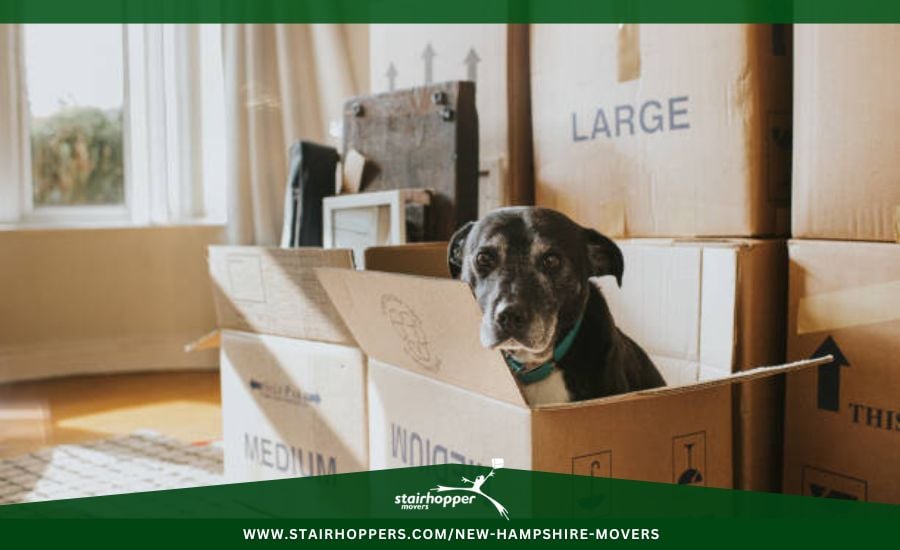Moving Long Distance with Pets: Expert Advice and Essential Tips

Moving long distance can be a stressful experience, especially when you have furry friends to consider. Pets are an important part of our families, and their well-being should be a top priority during the moving process. Whether you’re moving across the country or to a different state, it’s crucial to plan ahead and take necessary precautions to ensure a smooth and comfortable transition for your pets. In this article, we will provide expert advice and 10 essential tips to help you when moving long distance with pets.
Tips For Moving With Pets
Owning pets are like having young members in your family with an extra pair of legs. Just like children, pets can become anxious or confused during a move, so it’s important to take extra care and make necessary preparations to ensure a smooth transition. Here are 10 tips to help you move with pets and keep them safe and comfortable:
1. Update Identification and Microchips
Before embarking on a long-distance move, make sure your pets have up-to-date identification tags with your new contact information. It’s essential to have their name and your phone number clearly visible on the tags. Additionally, consider microchipping them if they aren’t already. Microchips are tiny electronic devices that are implanted under the skin and contain unique identification numbers. They greatly increase the chances of reuniting with your pets in case they get lost during the move. Ensure that the microchip information is updated with your new address and contact details.
2. Visit the Veterinarian
Schedule a visit to the veterinarian well in advance of your move. It’s crucial to ensure that your pets are in good health and up to date on vaccinations. The veterinarian will perform a thorough examination and address any health concerns. This is also an opportunity to discuss your travel plans with the veterinarian and obtain any necessary paperwork, records, or medication refills that you may need during the move. Remember to ask for a copy of your pets’ medical records to provide to the new veterinarian at your destination.
3. Research Pet-Friendly Accommodations
If your move involves overnight stays, it’s important to research and book pet-friendly accommodations along your route. Many hotels and motels have pet-friendly policies, but it’s essential to confirm their specific requirements and any additional fees beforehand. Look for accommodations that offer amenities such as pet-friendly rooms, designated pet areas, and nearby walking trails or parks. Check online reviews or ask for recommendations from other pet owners to ensure a comfortable and safe stay for both you and your pets.
4. Pack an Essentials Bag
Prepare a separate bag for your pets with their essentials. This bag should include their food, water, medication, toys, blankets, and any other items they may need during the journey. Having their familiar belongings will help provide comfort and reduce anxiety during the move. Remember to pack enough food and water for the duration of the trip, as well as any medications or supplements they require. It’s also a good idea to include a first-aid kit specifically for your pets in case of any minor injuries or ailments.
5. Plan for Travel
Consider the mode of transportation for your pets. If you’re traveling by car, make sure they are safely secured in a well-ventilated carrier or crate. The carrier should be large enough for them to stand, turn around, and lie down comfortably. Place familiar bedding or blankets inside the carrier to make it more comfortable for them. If you’re flying, check the airline’s pet policies and guidelines for transporting pets. Each airline has specific requirements regarding carrier dimensions, health certificates, and other documentation. Remember to make reservations and arrangements in advance, as airlines have limited space for pets.
6. Maintain Routine and Familiarity
Pets thrive on routine, so try to maintain their regular feeding, exercise, and sleep schedules as much as possible during the move. Stick to their usual feeding times and portions to keep their digestion regular. Take breaks during the journey to give them the opportunity to stretch their legs and have some exercise. Keep their belongings, such as bedding or toys, easily accessible to provide a sense of familiarity and comfort during this transition. If your pets are used to a certain type of food or brand, try to keep their diet consistent to avoid any stomach upset.
7. Keep Calm and Provide Comfort
Moving can be stressful for both humans and pets. It’s important to stay calm and provide comfort to your pets throughout the process. Spend quality time with them, offer treats, and provide a quiet space where they can retreat when they need some downtime. Use calming aids such as pheromone sprays or anxiety wraps if your pets are prone to stress or anxiety. Provide reassurance through soothing words and gentle petting. Your calm and reassuring presence will help alleviate their anxiety and make them feel safe and secure.
8. Take Breaks and Stretch Their Legs
During long-distance travel, it’s important to take breaks every few hours to allow your pets to stretch their legs, use the bathroom, and have some exercise. This is especially crucial if you’re traveling by car. Find pet-friendly rest stops or parks along your route where your pets can have a chance to walk, run, and relieve themselves. Remember to keep them on a leash or in a secure area to prevent them from getting lost in unfamiliar surroundings. Provide them with fresh water and a small snack during these breaks to keep them hydrated and satisfied.
9. Gradual Introductions to the New Home
Once you arrive at your new home, give your pets time to acclimate to their new surroundings. Set up a designated area with their familiar belongings, such as their bed, toys, and litter box for cats, to help them feel more at ease. Gradually introduce them to different rooms in the house, allowing them to explore at their own pace. It’s important to supervise them initially to ensure their safety and prevent any accidents. Provide plenty of positive reinforcement, praise, and treats when they exhibit good behavior in their new environment.
10. Find a New Veterinarian
Research and locate a new veterinarian in your new area before the move. Ask for recommendations from local pet owners or use online resources to find a reputable and trusted veterinary clinic. It’s important to have a new veterinarian lined up to provide any necessary follow-up care for your pets. Schedule an appointment for your pets’ initial check-up and to update their records. Discuss any concerns or questions you may have regarding your pets’ health or well-being in the new location. The veterinarian will be able to provide valuable advice specific to your pets’ needs in the new environment.
Move Anywhere Seamlessly with Stairhopper Movers
Moving can be overwhelming, but with proper preparation and attention to your pets’ needs, you can make the transition a positive experience for everyone involved.
When moving long distance with pets, it can also be beneficial to seek the assistance of professional movers who understand the unique needs of pet owners. Stairhopper Movers is a reliable and reputable moving company that specializes in residential and commercial moves. They have experience in safely and efficiently transporting pets during long-distance moves. With their expertise and commitment to customer satisfaction, Stairhopper Movers can provide you with a stress-free moving experience, ensuring the well-being of your pets throughout the journey.
FAQ
How can I ensure the safety of my pets during a long-distance move?
Ensure the safety of your pets by updating their identification tags and microchips, securing them in a well-ventilated carrier or crate, and maintaining their routine and familiarity throughout the journey.
What should I include in my pets’ essentials bag?
In your pets’ essentials bag, include their food, water, medication, toys, blankets, and any other items they may need during the journey. Don’t forget a first-aid kit specifically for your pets.
How can I help my pets adjust to their new home after a long-distance move?
Help your pets adjust to their new home by setting up a designated area with their familiar belongings, gradually introducing them to different rooms, and providing plenty of positive reinforcement and treats.
What should I do if my pet gets stressed or anxious during the move?
If your pet gets stressed or anxious, stay calm and provide comfort through quality time, treats, and a quiet space for them to retreat. Consider using calming aids like pheromone sprays or anxiety wraps.
How can I find a new veterinarian in my new area?
Research and locate a new veterinarian in your new area before the move by asking for recommendations from local pet owners or using online resources. Schedule an appointment for your pets’ initial check-up and to update their records.


